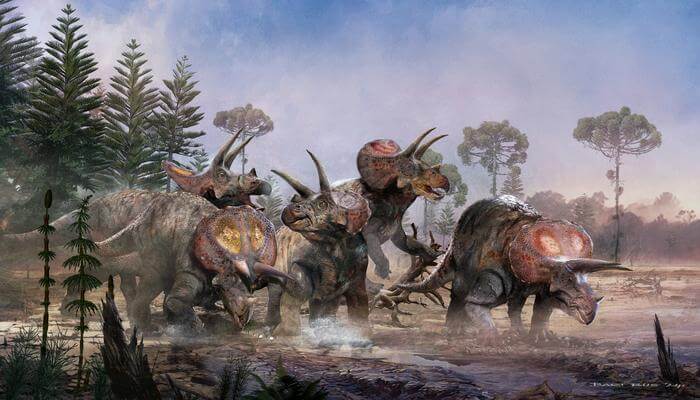A decade-long study shows that five three-horned dinosaurs lived - and died - together, similar to their depiction in Steven Spielberg's Jurassic World

In 2014, an internet star named Jay Branscomb published a post with a photo of Spielberg against the background of the authentic-looking rhinoceroses, built especially for the 1993 film "Jurassic Park," with the caption: "A shameful photo of an amused hunter, happily posing next to a triceratops Just murder. Please share, so that the world knows about the exploits of this despicable man.' While most commenters realized it was a joke, writer Joyce Carol Oates retweeted this post, embarrassing herself and calling Spielberg a "barbarian," and wondering how dinosaurs aren't protected by law.
The triceratops, one of the last species of dinosaurs that lived on earth until the extinction of the dinosaurs were all depicted in the film as being in groups. A study is now being published that confirms this.
A team from the Naturalis Center for Biodiversity in the Netherlands searched for Tyrannosaurus in the summer of 2013 in Wyoming. Instead, they found Triceratops: the famous dinosaur with three horns and a large neck bow. Then they found another one. and one more. and more. The excavation became a project that lasted more than ten years.
In total, they dug up 1200 bones and bone fragments, of at least five individuals. A team of professional paleontologists and volunteers and technicians spent years removing them from the mine. A university researcher was hired to study the fossils: how did these dinosaurs get here and more together? What do their bones tell us about their life and death? This researcher, Jimmy de Roy, submitted his doctoral thesis to the University of Utrecht.
"The material is of very good quality," explains De Rooy. "Thanks to this quality, we were able to show, for example, that these Triceratops grew very slowly." The details of the bone layer indicate that the five dinosaurs died together, probably sinking in a swamp. They are found in a thin layer of rock, without bones of other species.
The study of the physical and chemical properties of hundreds of triceratops teeth tells about walking in a group. In other words: these dinosaur species banded together, at least sometimes. "And this of course leads to various new questions," says de Roy: "How complex was their social behavior, exactly?"
De Rooy's supervisor, Prof Anne Scholpe (Naturalis/Utrecht University), says: “Naturalis, the Dutch National Museum of Natural History, now has the largest triceratops site in the world, and Utrecht University has the first triceratops doctor in the Netherlands. De Roy's work not only led to research papers, but also to an exhibition about his findings. Starting in October, the exhibition will begin in Naturalis - and begin a world tour - where the five triceratops will be presented as they lived and died 67 million years ago: together."
The study received funding from the Research Council of the Netherlands.
More of the topic in Hayadan:
